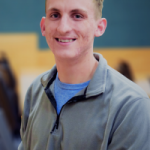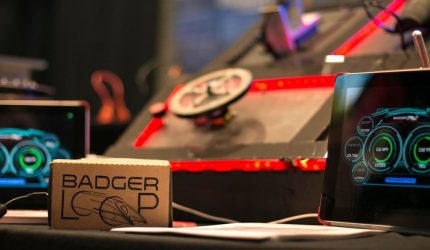When the Badgerloop team began their quest to design and build their entry into SpaceX’s Hyperloop competition, they knew that innovation would be critical at every juncture, from the Halbach wheels to the perfectly Elon Musk-sized seating. What the team of mostly undergraduates may not have expected was that virtual reality (VR) would become a prominent component of Badgerloop.
Early in the project, a basic VR setup allowed users to view the inside of the Badgerloop pod. The feature was so popular at the initial design competition that the team committed to further VR development. To do so, they tapped the expertise of Peter Procek, who was at the time an undergraduate research assistant in the Living Environments Laboratory (LEL) at the Wisconsin Institute for Discovery.

Procek had been working with LEL on multiple VR initiatives using LiDAR to capture real world environments and doing the technical work needed to be able to display those environments in the CAVE. When he saw an email from Badgerloop, he jumped at the chance to get involved, at first helping with electrical and control systems before eventually becoming the Badgerloop VR team leader. “It was a great opportunity to introduce VR into an engineering project,” says Procek.
Beyond beefing up Badgerloop’s VR capabilities, Procek saw an opportunity to address three key issues. First, engaging VR experiences can be powerful marketing tools. Promoting Badgerloop (and the Hyperloop contest in general) with VR creates a potential draw for sponsors and public interest.
“They provided a really great opportunity for me to dive into VR… LEL is where I saw that you can have a viable, meaningful application of VR that goes way beyond gimmicks and gaming.”
– Peter Procek
Second, Procek views VR as having multiple meaningful applications in Badgerloop — from design, where VR can be used as an auxiliary tool to virtually prototype physical components in full scale before fabrication, to simulation, which might help alleviate some people’s uneasiness about Hyperloop technologies. “The pods that shoot down the tracks are small and people might be apprehensive about getting into one,” says Procek. VR can ease that apprehension by giving users an idea of “what it might feel like to be inside a Badgerloop pod.”
Finally, Badgerloop has provided new opportunities for students to investigate topics in VR such as design, presence, immersion and haptics. With few relevant courses for VR-interested students available in the Computer Sciences department, Procek initially joined LEL to get hands-on VR experience and training. “They provided a really great opportunity for me to dive into VR… LEL is where I saw that you can have a viable, meaningful application of VR that goes way beyond gimmicks and gaming.”
With Badgerloop, Procek has an opening to bring more students into the fold. “We wanted to provide a platform for students to learn VR applications and to learn graphics concepts,” he says. When Procek originally built the Badgerloop VR team, one of his first recruits was another LEL undergraduate assistant: junior computer engineering and computer sciences double-major Cale Geffre.

When the Badgerloop team visited the SpaceX headquarters in Hawthorne, California, in late January for the worldwide Hyperloop pod competition, Geffre felt very much at home displaying Badgerloop’s VR capabilities. “Working at LEL I’ve done lots of outreach events where I show off VR technology,” he says, “so it’s becoming really natural to me to do that.”
Badgerloop received one of two innovation awards at the competition, partly thanks to the VR setup that accompanied their pod. The award is something the undergraduate-led team is very proud of, and indicates that VR has a bright future for Badgerloop.
Geffre credits LEL with providing a crucial early opening that led him to Badgerloop and, perhaps someday, might lead to a career in VR or graphics: “LEL has provided me with all of these opportunities, and it’s been a nice linear process of getting involved in more projects like this. It’s been awesome.”
Procek graduated from UW-Madison in December 2016 with a degree in electrical and computer engineering, but he is not done with Badgerloop; he is still the VR team lead, developing the next phase of Badgerloop VR with big, bold ideas. “All of this has been of great interest to me,” he says, “and it’s very exciting to be a part of it.”
— Nolan Lendved


You must be logged in to post a comment.